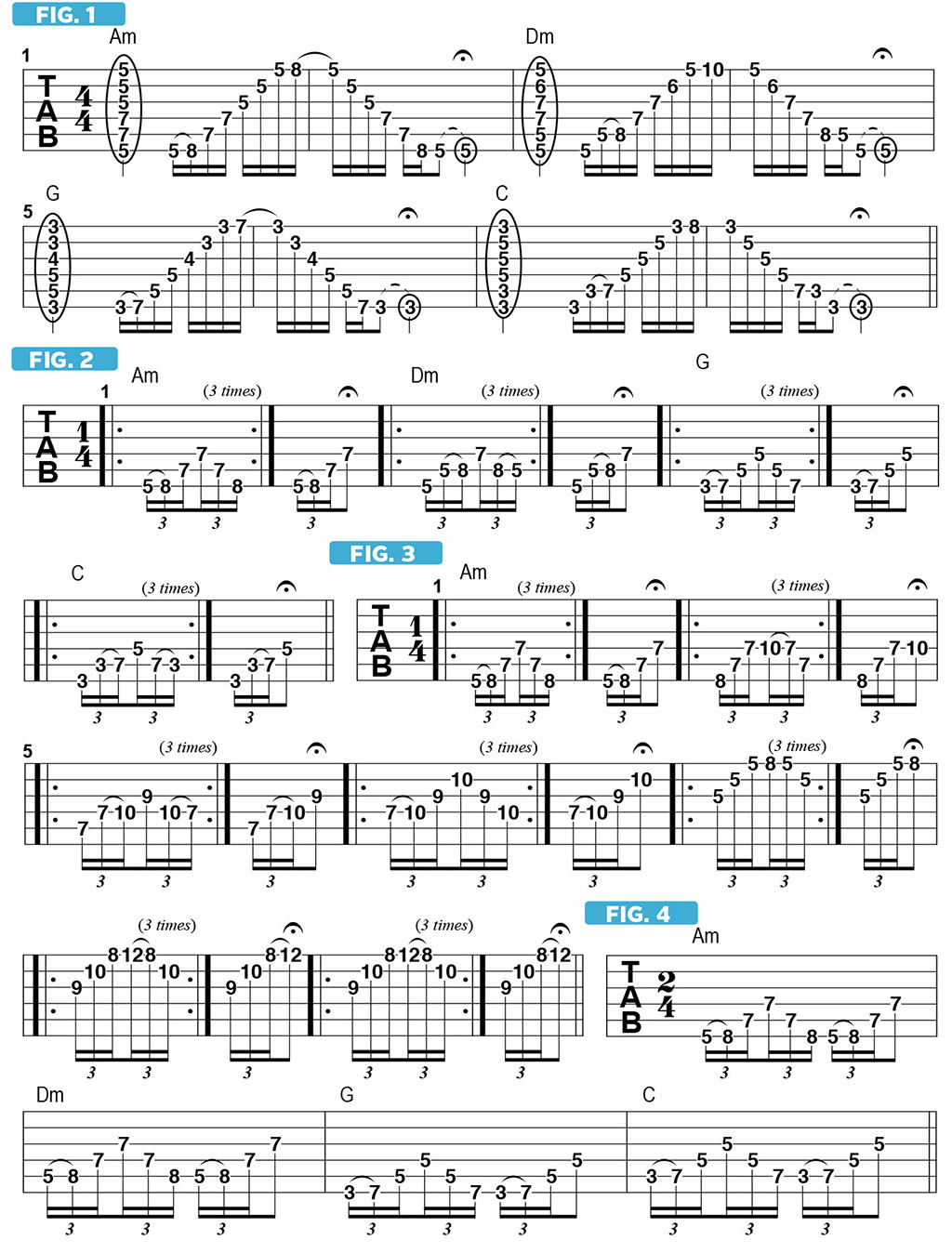How to Apply Arpeggio Patterns to a Cycle-of-Fourths Progression
Performing arpeggio patterns in this style poses interesting technical and fingering challenges that have been embraced by guitarists of every ilk.
Over the last two columns, we examined different approaches to playing arpeggios over a cycle-of-fourths progression, for which each chord is rooted either a fourth above or a fifth below the previous one. As you recall, the method for determining what note or chord is a fourth above another one involves counting up through the seven-note major scale. In the key of A, the notes of an A major scale are A(1) B(2) C#(3) D(4) E(5) F#(6) G#(7). We can see D is the fourth of A. We can then use the same formula to find the fourth up from D. The D major scale is spelled D(1) E(2) F#(3) G(4) A(5) B(6) C#(7). And so the fourth of D is G, as G is that scale’s fourth degree. If we were continue this process 12 times, the resultant cycle-of-fourths progression eventually brings us back to A, as follows: A D G C F Bb Eb Ab Db Gb B E A.
Cycle-of-fourths chord progressions can be found in virtually every style of music but are most prevalent in baroque classical music, such as that of the great composer Johann Sebastian Bach. Bach wrote many cycle-of-fourths arpeggio patterns for various instruments, especially violin and cello, since the only way to play a four-note chord on either of these instruments is as an arpeggio. Performing arpeggios, such as these on guitar, poses interesting technical and fingering challenges that have been embraced by guitarists of every ilk. The principal initiative in the following examples is to find ways to play through the series of arpeggios while remaining in close proximity on the fretboard. We have started our cycle of fourths progression with Am and Dm, followed by a series of major chords.
FIGURE 1 illustrates the basic ascending/descending forms of each arpeggio as related to each chord, starting on Am and followed by Dm, G, and C. Feel free to continue through the remaining eight chords in the complete cycle-of-fourths progression. These patterns can be challenging to play when using alternate (down-up) picking as, for the most part, only one note is played per string.
Bach devised many interesting melodies based on arpeggios by creating repeating “cells,” like those shown in FIGURE 2. In this example, each chord is represented as a series of 16th-note triplets played in ascending and descending manner through one octave. Play through each “shape” slowly and carefully before increasing the tempo.

If one were to stay on Am and play through every available triad-based shape in this manner, the result would be the set of “cells” shown in FIGURE 3. It is of great value to memorize all of these triadic forms.
Lastly, FIGURE 4 offers an example of moving more quickly through the progression by switching chords every two beats. Once you have the concept down, continue this pattern through all 12 chords in the progression.
Guitar World Associate Editor Andy Aledort is recognized worldwide for his vast contributions to guitar instruction, via his many best-selling instructional DVDs, transcription books and online lessons. Contact Andy at andyaledort.com.
Get The Pick Newsletter
All the latest guitar news, interviews, lessons, reviews, deals and more, direct to your inbox!
Guitar World Associate Editor Andy Aledort is recognized worldwide for his vast contributions to guitar instruction, via his many best-selling instructional DVDs, transcription books and online lessons. Andy is a regular contributor to Guitar World and Truefire, and has toured with Dickey Betts of the Allman Brothers, as well as participating in several Jimi Hendrix Tribute Tours.
“There are so many sounds to be discovered when you get away from using a pick”: Jared James Nichols shows you how to add “snap, crackle and pop” to your playing with banjo rolls and string snaps
Don't let chord inversions bamboozle you. It's simply the case of shuffling the notes around








![Joe Bonamassa [left] wears a deep blue suit and polka-dotted shirt and plays his green refin Strat; the late Irish blues legend Rory Gallagher [right] screams and inflicts some punishment on his heavily worn number one Stratocaster.](https://cdn.mos.cms.futurecdn.net/cw28h7UBcTVfTLs7p7eiLe.jpg)


